Reply To:
Name - Reply Comment
Is the Press Association ‘Exclusive’?
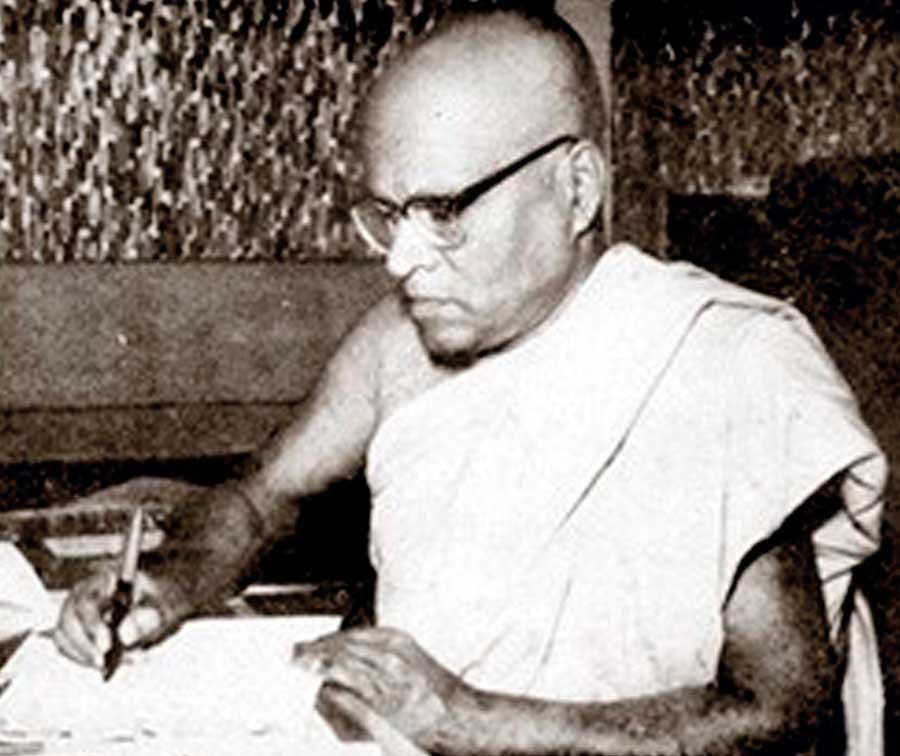
Ven. Udakendawala Siri Saranankara Thera
On February 08 this year, the Sri Lanka Press Association (SLPA) celebrated its 67th Anniversary at the Sri Lanka Foundation Institute. Former senior journalist and the present Media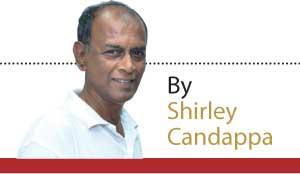 Minister Dullas Alahapperuma graced the occasion as Chief Guest, while Dr Punchinilame Meegaswatte – former Secretary-General of the Sri Lanka National Commission for UNESCO was the Guest of Honour.
Minister Dullas Alahapperuma graced the occasion as Chief Guest, while Dr Punchinilame Meegaswatte – former Secretary-General of the Sri Lanka National Commission for UNESCO was the Guest of Honour.
With this year’s commemoration of the founding of the SLPA taking place under a shadow of UNHRC resolution on Sri Lanka inquiring into gross violations of human rights and violations of international humanitarian law in our country and at a time when violence against journalists and press freedoms are increasingly coming under attack from ‘unknown sources’, it was hoped the Minister would enlighten the journalistic fraternity and the public on steps the Government was taking to secure journalistic freedom. Sadly this did not happen.
The 67th Anniversary of the SLPA commemorated the setting up of Sri Lanka’s first press association in what was then Ceylon. For 67 long years, the SLPA has functioned as an independent body and has transitioned Governments of different shades and hues and diverse ideologies.
The anniversary of the association also takes place at a time when the ugly head of nationalism based on language and religion is raising its head in the country.
Despite the tumultuous events taking place since its founding, including three violent attempts to overthrow the elected Governments of the country, from -1962 attempted coup d’état, two JVP uprisings of 1971 and 1989 and the war with the separatist LTTE which dragged on for around three decades, the SLPA faced the challenges with aplomb.
Even during these difficult times, the organisation continued to function, organising educational programmes on journalistic ethics, helping to improve connectivity between journalists in the country, in addition to introducing a course in journalism in association with the University of Colombo.
 Today this programme has developed into a degree course in journalism. The organisation is in the process of helping to develop a course for a post-graduate degree course. The association has also been able to offer succour to some of the members who faced pressure from different sources.
Today this programme has developed into a degree course in journalism. The organisation is in the process of helping to develop a course for a post-graduate degree course. The association has also been able to offer succour to some of the members who faced pressure from different sources.
The SLPA was founded by Ven. Udakendawala Siri Saranankara Thera, a Buddhist monk with Leftist leanings. He was also the winner of the Lenin Peace Award in 1955.
Ven. Saranankara Thera was at the time, editor of the Nawalokaya magazine and it was his initiative that led to the formation of the island’s first press association, which was initially named the Ceylon Branch of the International Organisation of Journalists (IOJ).
Though originally having a membership of a mere nine members in the country, internationally the organisation was able to play an influential role especially in helping formulate education programmes for journalists and forming a network of journalists both in-country as well as internationally.
Within two years of its formation, the organisation which commenced functioning with just nine members had grown to include in its fold, journalists from all major newspapers and magazines in the country including the Lake House group of newspapers than the largest newspaper group on the island.
The late D. F. Kariyakarawana - Chief Sub Editor of the Dinamina and member of the SLPA was one among a group of three journalists representing the SLPA, who were selected to visit London at the invitation of the British Government in 1957.
"A single shortcoming was noticed -the absence of Tamil/Muslim inclusivity in the event"
Kariyakarawana during his stay in London was deeply influenced by the activities of the British Press Association and its role in the formation of journalists in that country.
On his return to Ceylon -on the occasion of the second anniversary of the organisation- he played an important role in changing the name of the organisation from the Ceylon Branch of the International Organisation of Journalists to its present name -the Lanka Press Association- which was converted to Sri Lanka Press Association (SLPA) in 1972 when then Ceylon was proclaimed a Republic.
The aims of the SLPA were based on the principles of the British model.
It was also at that anniversary meeting, the concept of three Presidents representing the English, Sinhalese and Tamil media was conceptualised.
The SLPA and its then President D. F. Kariyakarawana was also instrumental in forming its trade union wing Sri Lanka Working Journalists Association (SLWJA) subsequently.
Sri Lanka Working Journalists Association was established on October 9, 1979. Journalists working in the print and electronic media, who met at the Sri Lanka Foundation Institute on that day, elected staff and marked the beginning of the SLWJA.
Mr D. F. Kariyakarawana was elected President, Mr Newton Seneviratne was elected Secretary and Mr R. Sivagurunathan was elected as the Treasurer of the Association.
A feature of Tuesday’s (8 February) event highlighted a painstakingly researched and choreographed history of the organisation. The organisers need to be congratulated for a superb job of work.
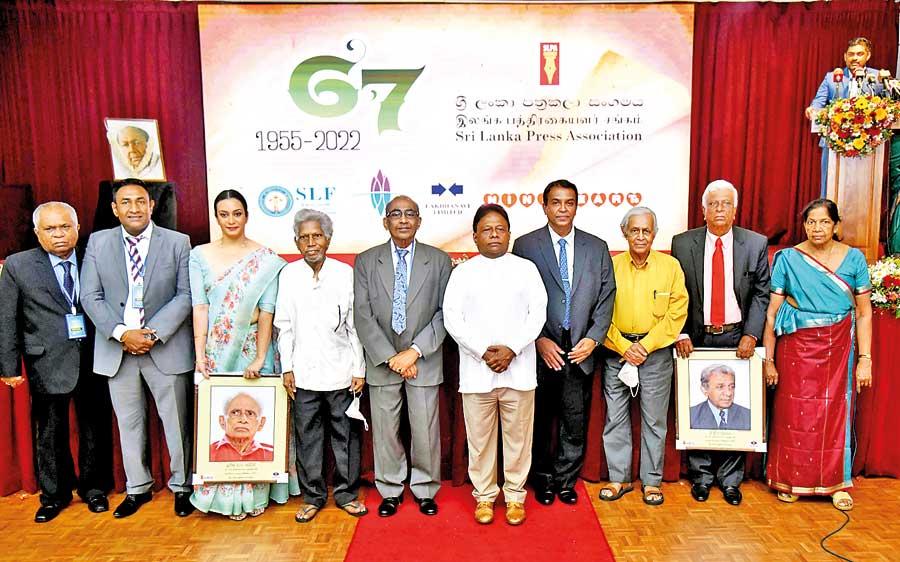
SLPA top office bearers with the awards recipients and the Minister of Mass Media.
However, a single shortcoming was noticed -the absence of Tamil/Muslim inclusivity in the event. It gave an appearance of Sinhala exclusivity. A serious lapse which this writer feels sure will be addressed at next year’s celebrations.
The anniversary celebrations got underway when journalist-turned-politician and present Media Minister Alahapperuma was ushered into the hall with a bevvy of Kandyan dancers leading the Chief Guest and Guest of Honour to the hall. This was followed by the lighting of the traditional oil lamp and recognition of the services rendered by five leading journalists namely Sunil Daya Alwis, Arthur U. Amarasena, Ms Chandrika Wijesuriya, Sarath Cooray and A. C. De Silva to the field of journalism.
Speaking at the event the minister was emphatic in his praise for journalists and journalism but was critical of online websites. He also spoke of various ways the Government tried to help the journalistic fraternity.
Journalists and invitees were hoping the Minister would give some indication of how the Government would /could provide journalists with some form of security to perform their duties without fear or favour.
Unfortunately, the problem has been left hanging fire.
Yet, sadly and scarcely two weeks after the Minister graced a journalist’s association commemorating its 67th anniversary, journalists are once again becoming targets of attacks by ‘unknown’ agents.
The Police seem supremely unable to identify or bring to book the culprits. The public has begun believing the events were orchestrated by hidden hands associated with the Government.
Worryingly, the ‘white vans’ of old seem to be reappearing once again.
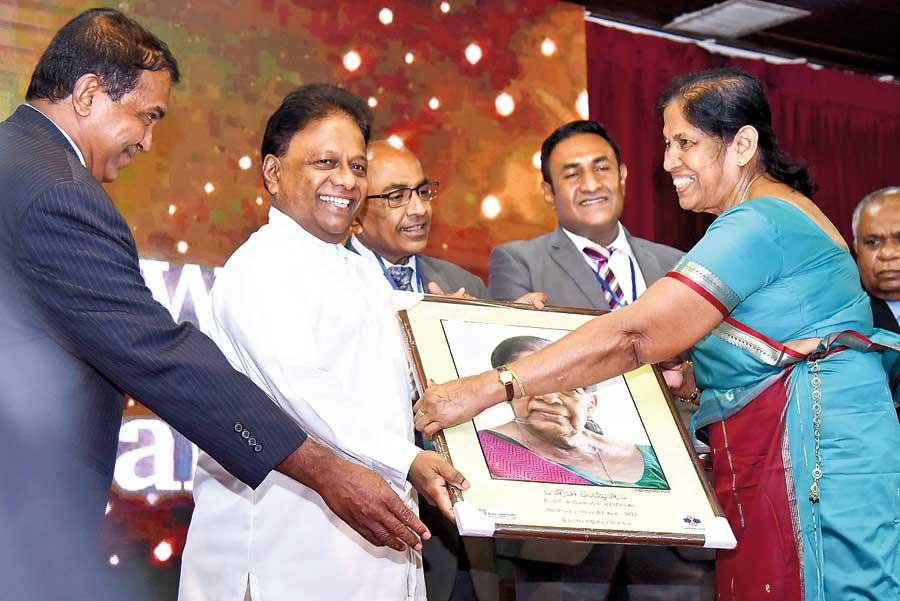
Former Lankadeepa Associate Editor Chandrika Wijesundera receiving her award.
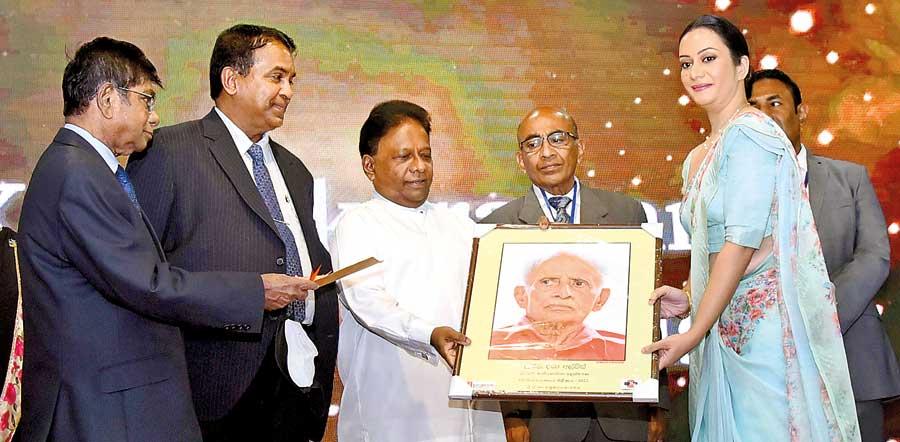
Late veteran journalist Sunil Daya Alwis’s daughter receiving the award.

Senior Sports Editor A. C. De Silva’s relative receiving the award.
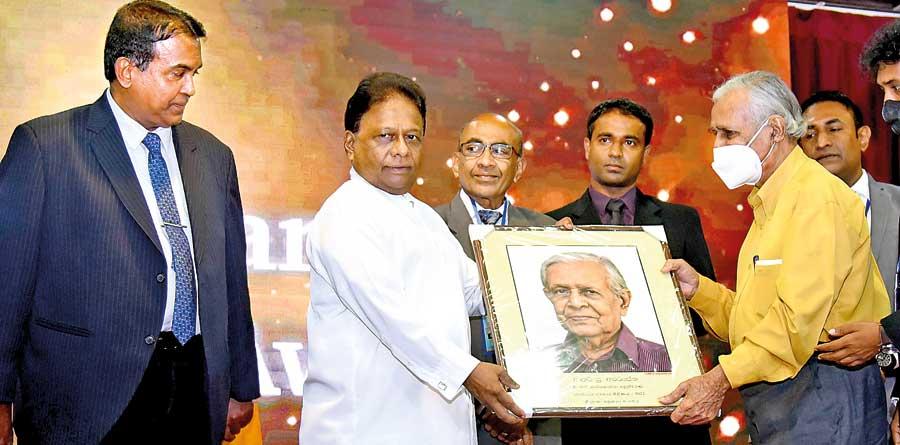
Senior Cinema Journalist Arthur U. Amarasena

Veteran Editor Sarath Cooray